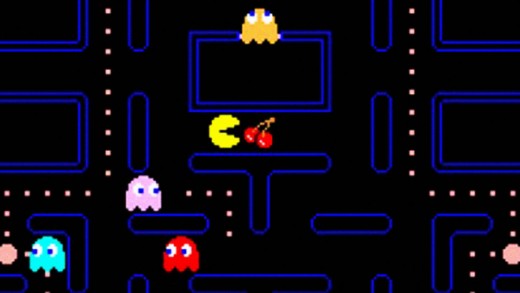From Cory Arcangel To “Pac-Man”: How Digital Art Curators Save Vintage Data And Hardware
Inside the struggle museum and gallery conservators face while fighting bit rot and broken parts.
As a teenager in the early 2000s, London artist Alexander Taylor and his friends shot videos on their Motorola Razr-era cellphones. They swapped the movies they made with one another in the already largely forgotten .3gp file format.
“It used to be quite a thing for all my friends to create these 3G videos,” says Taylor, now 24.
Years later, Taylor discovered a treasure trove of amateur feature-phone videos from around the world can be found on YouTube by searching for that .3gp extension. Many of them, he says, appear to have been bulk-uploaded from their creators’ phones or hard drives, with the filenames, complete with extension, becoming the YouTube titles.
Most of these videos have been watched only rarely—but that may soon change. Earlier this month, Taylor was awarded a grant from the New York digital art organization Rhizome to support a project he calls, simply, “.3gp.” He plans to build a web app, likely modeled after a classic cellphone interface, using YouTube’s API to let visitors digitally channel surf through the collection of videos, including the ones with only a handful of views.

“I’m going to try to make it random, so those get an equal viewing chance,” says Taylor.
The project, which he aims to launch within the next two months, comes as the art world is increasingly concerned with preserving digital and electronic works, from amateur digital videos like the ones Taylor’s celebrating to experimental pieces by international art stars like digital artists Cory Arcangel and video artist Nam June Paik, shown in museums and galleries. And as new media artists increasingly incorporate fleeting digital formats and even Internet content and commercial APIs into their work, curators are grappling with what it even means to preserve these pieces for future generations.
New media art’s become popular enough with collectors to sell for thousands of dollars and even tens of thousands, and digital art’s often seen as a way to interest younger generations in what art museums have to offer. But without effective conservation techniques, it’s hard to know if the artworks—the artistic explorations of the technologies that defined life in the 20th and 21st centuries—will survive long enough for collectors and future museum visitors to appreciate.
Moving Code, Hearts
“There is nothing to indicate that somehow this process is slowing down and maybe becoming stable,” says Jon Ippolito, a professor of new media at the University of Maine, where he leads the school’s graduate program in digital curation. “If anything, they’re becoming more unstable, and the conservators are just racing to find ways to capture them.”

For some digital art, that can mean finding ways to move code and images from failing machines to new ones, virtualizing old operating systems, or recompiling aging source code on modern machines. In 2004, while working as an associate curator at New York’s Guggenheim Museum, Ippolito was involved in an exhibition exploring the limits of emulation in new media conservation.
One piece in the exhibition, a 1980s interactive video installation called The Erl King, created by artists Grahame Weinbren and Roberta Friedman, was on the technological cutting edge of its day. A Sony computer, running the pre-DOS CP/M operating system from a floppy disk, used user input to cue up video from an array of analog laserdisc players. The piece let viewers explore a landscape inspired by an 1800s Goethe poem and the work of Sigmund Freud.
“It was remarkable for how the software was written,” says Ippolito. “It was remarkable for how people were able to interact with video in a way they hadn’t really before.”
But 20 years later, the piece was showing its age, and it was becoming impossible to replace parts like the laserdisc players as they began to fail.
“You can’t find them on eBay anymore, which means unless the work was sort of exhumed from its current body and injected in a new body, it was going to be dead to history,” says Ippolito.
The Guggenheim team decided to virtualize the project—moving the code to modern hardware, digitizing the video footage, and even programming an emulation layer to translate the original Pascal code’s commands to all those laserdisc players into 21st-century digital playback triggers. Importantly, Ippolito says, they were able to preserve the look and feel of the original—so much so that when the two were exhibited side by side, some museumgoers were confused as to why there were two identical works on display.
“The Erl King was an example where the artist had very clearly not intended it to be reduced to a particular technology,” he says. “He said, ‘I would have made it with Linux and a Java interpreter if I could have—I just didn’t have that available in 1982.’”

The Forensics Front
Over time, emulation’s gotten easier—museum curators aren’t the only ones interested in running old software, and the art world’s benefitted from work done by professional software makers and open source code from the video game community.
“There are a lot of issues involved in preserving born digital art that also apply to born digital culture, broadly writ,” says Richard Rinehart, the director of Bucknell University’s Samek Art Museum and the coauthor with Ippolito of Re-collection: Art, New Media, and Social Memory, a scholarly book on digital preservation released last year.
But even the most sophisticated emulator still requires a clean copy of each program and, ideally, the source code to help diagnose any bugs—something museums haven’t always thought to collect and artists have sometimes been reluctant to part with, Rinehart says.
To at least make clean archival copies of existing works, curators and archivists are increasingly experimenting with using digital forensics software, designed to make byte-for-byte drive images accurate enough to use in court, he says.
Last year at Miami’s Art Basel show, a digital artwork by artist Alexandra Gorczynski sold for $5,000, with the purchaser acquiring the work’s domain name, files to display the piece online, and on a standalone computer and source files “which can be used for future restoration,” according to a carefully crafted contract.
Still, migrating digital art to new hardware isn’t as simple as figuring out how to open an old email on a new laptop. In the Guggenheim exhibit, Ippolito says the team determined emulation just wasn’t the right way to preserve every work. In Nam June Paik’s 1960s TV Crown series, for instance, modified televisions display an audio signal as a colorful, oscillating visual pattern.
At the time, the idea of physically rewiring an analog television to create, rather than receive, a message seemed groundbreaking, and there’s no way to capture that on today’s hardware, meaning the piece will survive only as long as there are parts to maintain the analog televisions.
“This work we decided not to emulate, because to do so would basically be to just take a video of that and project it on a flat screen,” he says. “It would lose all its character—that subversive quality that made it exciting to begin with.”
Similarly, digital artist Cory Arcangel has said he’d only want his project I Shot Andy Warhol—a modified Nintendo game where viewers use the classic Nintendo light gun to shoot at cartoon images of figures like John Paul II and Colonel Sanders—exhibited with the original Nintendo hardware.
Still, Arcangel makes the game available for download for home play on his website, and he’s even sold the code for Andy Warhol and other projects in archival-friendly print formats, printed on acid-free paper, and optimized for scanning and character recognition. That’s also somewhat of an art project in its own right, but Arcangel’s one of a number of digital artists increasingly thinking about preservation, says Museum of Modern Art digital repository manager Ben Fino-Radin.
“I think that’s definitely an impulse that has existed with filmmakers and video artists for decades,” he says. “We’re just starting to see it emerge for artists that are working in digital media.”
Probing Pixels
It’s also a relatively new impulse for many museums and galleries, and it can still be a challenge for many smaller institutions to find the financial resources necessary to archive digital works. At MoMA, though, Fino-Radin says conservators work carefully to understand new digital acquisitions, the formats in which they’re stored and displayed, and the condition in which they’re received. That’s not always simple to do with interactive work, where it can be difficult to even ensure you’re seeing the entirety of a work, and hard to tell malfunctions from deliberate features, he says.

“How do you condition-assess a video game if it has 12 levels and it’s really, really hard?” Fino-Radin asks, speaking from a museum that made headlines a few years ago by formally acquiring a collection of classic video games, from Pac-Man to Dwarf Fortress.
Of course, museums aren’t the first to ask that question. It’s one that’s bedeviled game publishers and unhappy buyers of buggy games for years. And just as digitally focused art museums have benefitted from general-purpose emulation software and from forensic copying tools, they’ll also stand to benefit from any industry push toward better tools for working with old data and software.
And that’s something that seems almost inevitable as millions of people outside the formal art world build up their own collections of digital creations. The conservation problems facing the art world are increasingly also faced by ordinary people looking to hold on to their own digital photo albums, videos, blog posts, and other digital creations.
Fast Company , Read Full Story
(171)



